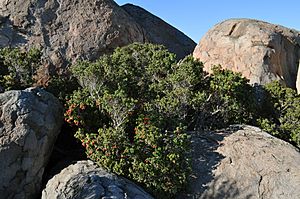Lucumillo facts for kids
Quick facts for kids Lucumillo |
|
|---|---|
 |
|
| Scientific classification | |
| Genus: |
Myrcianthes
|
| Species: |
coquimbensis
|
The lucumillo (scientific name: Myrcianthes coquimbensis) is a cool evergreen shrub. It belongs to a plant family called Myrtaceae, which includes plants like eucalyptus. This special plant only grows in the Coquimbo Region of Chile. Sadly, it's an endangered plant, meaning it's at risk of disappearing. It also grows yummy, edible fruit!
Contents
What the Lucumillo Looks Like
The lucumillo is a small, round, and bushy plant. It smells nice and can grow up to about 1.5 meters (5 feet) tall.
Its leaves stay green all year round. They are oval-shaped, thick like leather, and have rounded tips. Each leaf is about 1.5 to 2.5 cm long and 1.2 to 1.8 cm wide. The side veins on the leaves grow almost straight out from the middle vein.
The lucumillo has small white flowers. They grow either by themselves or in groups of three. Each flower has five petals and many stamens that stick out.
After the flowers, the plant grows a fleshy, edible berry. This fruit is about 1.5 to 2 cm wide. It turns bright red when it's ready to eat. Each berry usually has one or two seeds inside. The remains of the five sepals stay on top of the fruit.
Where the Lucumillo Lives
The Myrcianthes coquimbensis plant is special because it only grows in Chile. You can find it along about 83 kilometers (52 miles) of the coast in the Elqui Province. This area is part of Chile's Coquimbo region.
This shrub loves to grow on coastal rocks. These spots are often wet from the mists that blow in from the Pacific Ocean. Sometimes, you can find them in other places too.
The lucumillo often grows near other plants and shrubs. Some of its plant neighbors include Bridgesia incisifolia, Oxalis gigantea, Heliotropium stenophyllum, Bahia ambrosioides, and Polyachyrus poeppigii.
Why the Lucumillo is Endangered
The lucumillo is considered an "endangered" species. This means it's at risk of disappearing forever. There are a few reasons why:
- Habitat Loss: The places where it naturally grows are shrinking.
- Trouble Growing: The plants sometimes don't flower or produce fruit well.
- Few New Plants: Because of these problems, not many new young lucumillo plants are growing.
See also
- Myrceugenia obtusa
- Pouteria valparadisaea
- Eugenia calycina
 In Spanish: Myrcianthes coquimbensis para niños
In Spanish: Myrcianthes coquimbensis para niños

